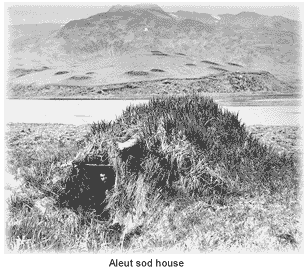The Aleuts constituted several peoples related to the Eskimos, but they had their own language and culture. They were the original inhabitants of southwest Alaska, the Kodiak archipelago and the Aleutian Islands, stretching some 1,100 miles toward Asia. The region was characterized by nearly treeless, rocky shores teeming with a rich array of wildlife on land and in the sea.
Although warmer than the Arctic, the weather also presented challenges to the Aleuts, thanks to its capricious, cloudy storms heavy with rain, snow and wind. In turn, the sea was equally restless.
Splendid seamen, the Aleuts used skin-covered baidarkas (kayaks) to pursue sea lion, seals and whales. They also caught fish, principally salmon, and harvested birds, eggs and plants.
 Numbering an estimated 12,000 to 25,000 before Russian contact, the Aleuts lived in isolated, widely spaced villages. Their dwellings, some made of sod, were half-buried in the earth. Some groups utilized summer fish camps.
Aleut society was hierarchical, with nobles at the top and slaves at the bottom. Like so many aboriginal groups, the main agent of their spiritual life was the shaman (so-called medicine man) who was responsible for rituals, taboo enforcement and healing.
When the Russians arrived in the 1750s, their missionaries introduced the Orthodox faith, which dramatically altered the Aleuts' religious life. Intermarriage also took place, producing Creole offspring and Russian family names. The Russian promyshlenniki (fur hunters and traders) also forcibly exploited the Aleuts' subsistence skills to collect valuable sea otter, seal and fox furs. Another encroachment on their lives was foreigner-introduced diseases. These, and cruel treatment, debilitated and severely reduced Aleut populations to an estimated 8,000 today.
Numbering an estimated 12,000 to 25,000 before Russian contact, the Aleuts lived in isolated, widely spaced villages. Their dwellings, some made of sod, were half-buried in the earth. Some groups utilized summer fish camps.
Aleut society was hierarchical, with nobles at the top and slaves at the bottom. Like so many aboriginal groups, the main agent of their spiritual life was the shaman (so-called medicine man) who was responsible for rituals, taboo enforcement and healing.
When the Russians arrived in the 1750s, their missionaries introduced the Orthodox faith, which dramatically altered the Aleuts' religious life. Intermarriage also took place, producing Creole offspring and Russian family names. The Russian promyshlenniki (fur hunters and traders) also forcibly exploited the Aleuts' subsistence skills to collect valuable sea otter, seal and fox furs. Another encroachment on their lives was foreigner-introduced diseases. These, and cruel treatment, debilitated and severely reduced Aleut populations to an estimated 8,000 today.